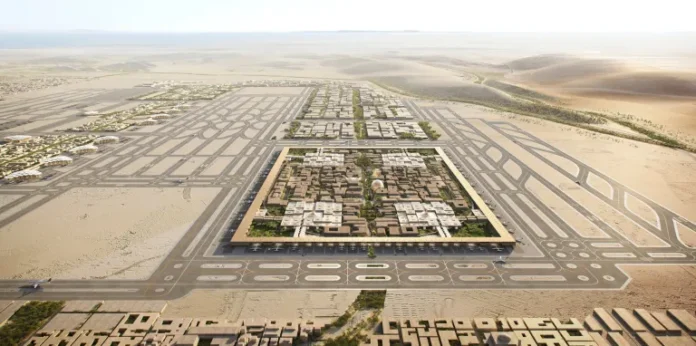In a monumental leap for global aviation, Saudi Arabia is set to unveil King Salman International Airport in Riyadh by the year 2030.
Anticipated to be the largest airport in the world, this ambitious project promises not only to redefine air travel but also to bolster Riyadh’s status as a key economic hub on the world stage.
Spanning an impressive 57 square kilometers, with 12 square kilometers dedicated solely to retail spaces, King Salman International Airport aims to seamlessly integrate existing infrastructure from the current King Khalid International Airport.
Designed under the expert guidance of Foster + Partners, renowned for their iconic architectural feats, the airport will feature six mammoth runways and accommodate an estimated 120 million passengers annually upon its opening.
The scale of this project is not just limited to its physical dimensions. It is projected to create approximately 150,000 jobs across various sectors, ranging from air traffic control to hospitality services, including the ubiquitous pre-flight baristas.
This surge in employment opportunities underscores Saudi Arabia’s commitment to stimulating its economy and promoting tourism in the region.
“The airport project is in line with Saudi Arabia’s vision to transform Riyadh into one of the world’s top ten city economies,” emphasized a statement from the Saudi Press Agency.
With a projected increase in passenger traffic to 185 million by 2050, the airport’s strategic location and expansive facilities are poised to cater to the burgeoning demands of global travel and commerce.
For aviation enthusiasts and travelers alike, King Salman International Airport promises a multifaceted experience beyond mere transit.
From state-of-the-art facilities designed to enhance passenger comfort to a sprawling retail landscape where shopping meets convenience, every aspect of the airport’s design aims to elevate the travel experience.
Moreover, the construction of King Salman International Airport signifies Saudi Arabia’s proactive approach in advancing its infrastructure to accommodate future growth.
By facilitating easier access to Riyadh, the airport aims to attract a diverse influx of visitors, thereby supporting the kingdom’s broader economic diversification goals.
As the world eagerly anticipates the unveiling of this aviation marvel, speculations abound regarding which airlines will seize the opportunity to operate from this prestigious hub.
While official announcements are yet to be made, the promise of increased connectivity and efficiency is set to redefine global travel patterns and establish Riyadh as a pivotal gateway between East and West.
With its grand opening slated for 2030, King Salman International Airport represents not just a logistical triumph but a symbol of Saudi Arabia’s ambition and vision for the future.
As the countdown begins, the world watches with anticipation as Riyadh prepares to welcome travelers to a new era of aviation excellence.
In summary, King Salman International Airport is poised to set new benchmarks in the aviation industry, promising a seamless blend of innovation, efficiency, and scale.
As construction progresses and anticipation builds, one thing is certain: the world’s largest airport is set to make an indelible mark on global travel and the economic landscape of Riyadh for decades to come.
This article was created using automation technology and was thoroughly edited and fact-checked by one of our editorial staff members

